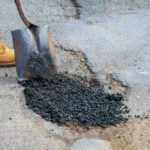Potholes and their fixing. Natural wear and tear cause porous pavements like concrete to lose their protective layer after a few years. The same thing can happen with asphalt paving. When these surfaces lose their protective coating, water starts to accumulate in their pores.
 From season to season, accumulated water freezes and thaws, causing the asphalt pavement to erode from within, resulting in pavement cracks. Water can penetrate deep into the cracks, weakening the foundation soil under it. It can then freeze and melt multiple times, putting the ground level and solidity at risk.
From season to season, accumulated water freezes and thaws, causing the asphalt pavement to erode from within, resulting in pavement cracks. Water can penetrate deep into the cracks, weakening the foundation soil under it. It can then freeze and melt multiple times, putting the ground level and solidity at risk.
When water freezes, it expands the ground beneath it, causing the asphalt pavement to rise. When the water thaws, the ground returns to normal, but the pavement remains raised. This cycle can cause stability issues that eventually lead to potholes in asphalt pavement.
Pothole Repair Tips
- Clean the pothole: Dirt and debris that can get into and beneath the pavement must be cleaned up. The presence of broken pavement pieces mixed in with fresh pavement can undermine the pothole repair.
- Heat the pothole: Heating the hole evaporates any excess moisture in the old pavement while also softening the area to lay the new asphalt. Once softened, the pothole can be reshaped, and old asphalt can be easily removed.
- Add the new asphalt: Hot mix asphalt is often used for pothole repair. After laying the asphalt, it must be compacted to reduce water penetration and increase resistance. The compaction cements the old and new asphalt pavements together.
Avoiding Potholes Tips
Now that you know how to perform a pothole repair job, you should also know how to avoid potholes. Potholes can cause serious damage to your vehicles, such as punctured tires, bent rims, suspension damage, misaligned steering wheel, broken exhaust or muffler, engine damage, and other issues.
To avoid potholes and protect your vehicle, follow these five tips:
- Keep an eye out for anything unusual. Keep your eyes on the road and be mindful of what’s ahead of you. Keep your phone away.
- Maintain a safe following distance. You have no idea how the driver in front of you will respond if they suddenly notice a pothole. You will be able to brake safely and have a better view of what lies ahead if you maintain a safe following distance.
- Do not swerve off the road. While swerving may seem to be the safest option, it may actually put you in more danger. You could cause your tire(s) to hit the pothole at an angle, causing extra damage to your vehicle, or worse, drive into oncoming traffic. If you cannot avoid the pothole safely, slowly break before the pothole, let go of the brake before the pothole, and hit it head-on.
- Keep an eye on your speed. If you are driving on a road that has seen better days, slow down and think about taking a different route.
- Keep an eye out for water. Wide potholes can collect water from nearby piles of snow and rainfall, making it difficult to accurately estimate the depth of the pothole.
Address
Commonwealth Paving, 136 Outerloop, Louisville, Kentucky 40214
Phone: 502-459-7283, Fax: 502-456-2678
Opening Hours
| Monday | 9:00 AM – 5:00 PM |
| Tuesday | 9:00 AM – 5:00 PM |
| Wednesday | 9:00 AM – 5:00 PM |
| Thursday | 9:00 AM – 5:00 PM |
| Friday | 9:00 AM – 5:00 PM |
| Saturday | Closed |
| Sunday | Closed |







